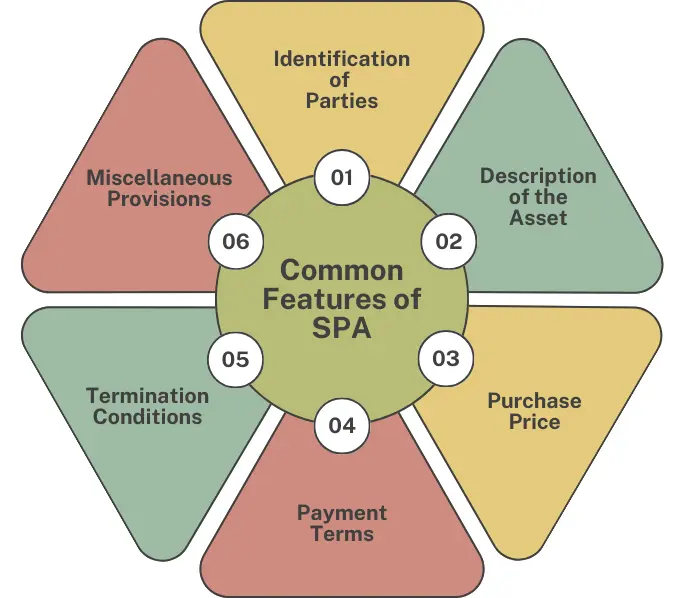In business deals, a legally binding agreement is key for a smooth transaction. It provides clarity, protection, and peace of mind for everyone involved. One important document is the Sales and Purchase Agreement, or SPA. This agreement lays out the terms and conditions of a sale. It defines payment schedules and addresses possible issues. SPAs help keep everything clear and confidential during the transaction process.
In this blog we will cover all the like the definition, key components, importance, and legal aspects of a Sales and Purchase Agreement, including its contents, differences from other contracts, examples in various industries, and frequently asked questions.
What Is a Sales and Purchase Agreement (SPA)?
A Sale and Purchase Agreement (SPA) is a formal contract between a buyer and a seller detailing the specifics of a transaction. It covers the sale of goods, real estate, or other assets, providing a clear framework for the exchange. The SPA is designed to protect both parties by setting out their rights and obligations, thus minimizing potential disputes.
Key Components of a Purchase and Sale Agreement

- Parties Involved: The SPA begins by identifying the buyer and the seller, including their full legal names and contact information.
- Description of the Asset: It provides a detailed description of the asset or property being sold, ensuring there is no ambiguity about what is being transferred.
- Purchase Price: The agreement specifies the amount the buyer will pay for the asset and outlines the payment terms, including any deposits or installment arrangements.
- Payment Terms: This section includes the method of payment, payment schedule, and any conditions related to financing or other payment arrangements.
- Closing Details: The SPA outlines the closing date and the procedures for transferring ownership, including the delivery of documents and payment of any closing costs.
You might want to read: What are Contract Obligations and How to Manage Them?
Understanding the Purchase and Sales Agreement

Before you finalize a sale, it is important to understand the purchase and sales agreement. This legally binding agreement acts like a guide. It lists the terms and conditions that both the buyer and the seller must follow.
Having a well-written agreement makes the transaction easier. It reduces the chances of confusion or problems later. It also clearly shows the agreed-upon terms and provides legal protection for everyone involved.
Importance of SPA
The importance of a Sale and Purchase Agreement (SPA) lies in its role in facilitating smooth and secure transactions. Here’s why an SPA is crucial:
- Legal Clarity: An SPA provides a clear and detailed outline of the terms and conditions of the sale, ensuring that both parties have a mutual understanding and agreement on the transaction.
- Risk Management: By addressing potential risks and including provisions such as warranties and representations, an SPA helps to minimize uncertainties and protect both parties from unexpected issues.
- Enforceability: As a legally binding document, an SPA can be enforced in court if necessary. It offers a framework for resolving disputes and ensuring compliance with the agreed terms.
- Structured Process: The SPA details the procedures for closing the transaction, including payment arrangements and the transfer of ownership, which helps to streamline the process and avoid delays.
- Protection of Interests: It includes clauses that safeguard the interests of both buyer and seller, such as indemnities and liability limits, which helps prevent financial loss and legal complications.
You might want to read: What is an Enterprise License Agreement (ELA)?
Differences Between Purchase Agreements and Other Contracts
This table highlights the key differences between Purchase Agreements and other common types of contracts like lease agreement, service agreement and employment contract.
|
Aspect |
Purchase Agreement |
Lease Agreement |
Service Contract |
Employment Contract |
|
Purpose |
Transfer ownership of goods or property. |
Grant temporary use of property or asset. |
Outline the terms of service to be provided. |
Define employment terms and conditions. |
|
Parties Involved |
Buyer and seller. |
Lessor (property owner) and lessee (tenant). |
Service provider and client. |
Employer and employee. |
|
Consideration |
Purchase price for the asset. |
Rent payments over the lease term. |
Fees or payments for services rendered. |
Salary or wages for work performed. |
|
Duration |
Typically a one-time transaction. |
Fixed term with start and end dates. |
Duration varies based on the service agreement. |
Ongoing, with terms for termination and renewal. |
|
Transfer of Ownership |
Yes, ownership of the asset is transferred. |
No transfer of ownership, only temporary use. |
No transfer of ownership, only provision of services. |
No transfer of ownership, only employment. |
|
Obligations |
Delivery and payment terms, asset condition. |
Maintenance of property, payment of rent. |
Scope of work, deadlines, quality of service. |
Job responsibilities, working hours, benefits. |
|
Termination |
Usually involves a breach of terms or mutual agreement. |
Ends when the lease term expires or if terminated early. |
Ends upon completion of the service or termination of the agreement. |
Termination conditions based on performance or other factors. |
You might want to read: What is Limitation of Liability Clause?
Contents of a SPA

It starts by naming the two sides involved: the buyer and the seller. The agreement clearly describes what is being sold, including goods, services, or assets.
A key part of the agreement is the purchase price. This shows the amount that both parties have agreed on and how the payment will be made. A good SPA will also have conditions that need to be met before the sale is completed.
What are the Contents of a SPA?
Each purchase and sale agreement contains transaction information such as:
1. Earnest money: This is a small deposit put down by the buyer “in good faith,” to indicate their seriousness about the SPA, which is specific about several earnest money details, including:
- The amount of earnest money to be deposited.
- Any mitigating circumstances that could cause the buyer to receive the funds back.
- The amount of time the buyer has to do due diligence such as a home inspection.
- Who will manage the earnest money (usually a title agent or escrow agent).
2. Asset identification: This specifies the asset that is being sold. If it is real property, that will include a physical address, parcel number, etc.
3. Closing date: With the stated planned closing date, the sale process is set in motion. Following the SPA will be an inspection, title search, appraisal, loan agreement, and money transfer, all of which must occur before closing. The agreement also establishes where the closing will occur.
4. Purchase conditions: This includes the purchase price, the establishment of which is a major SPA purpose. Note, though, that it is possible for the price to change or be renegotiated post signing. For example, there could be a home inspection issue.
5. Due diligence: There is often a SPA section that requires the buyer to acknowledge that due diligence must be conducted during the process and specifies during what periods. The section can also require acknowledgement of the asset’s condition.
You might want to read: The Importance of Centralized Contract Repositories
Examples of SPAs in the Marketplace
SPA agreements, are useful tools used in many different industries. A common place to find SPAs is in real estate.
A Sales and Purchase Agreement (SPA) in the real estate market is a legally binding document between a buyer and seller, outlining the terms and conditions of a property transaction. It details crucial elements like the sale price, property description, payment terms, and closing date. The agreement also addresses contingencies, such as financing or property inspections, allowing either party to withdraw if these conditions aren’t met. An SPA ensures both parties have a clear understanding of their rights and obligations throughout the transaction.
For instance, in the case of residential real estate, the SPA will specify aspects such as the property’s condition, warranties, and possible repairs before closing. It also highlights the timeline for the transfer of ownership, ensuring the buyer secures the necessary funds and the seller clears any outstanding obligations like liens. Such agreements offer protection, reducing potential disputes post-closing by making all terms explicit and agreed upon in writing.
Do I Need a Sales and Purchase Agreement?

Having a SPA is very important, even for small deals. It might seem okay to skip it in informal exchanges, but an SPA gives big benefits to both buyers and sellers. Even in simple transactions, an SPA acts as a legal record of the terms everyone agreed on. It helps avoid problems or arguments later.
This is even more important in bigger and more complex deals. Without a written agreement, disagreements can become expensive legal fights. An SPA creates a clear way to manage issues, defaults, and solutions. It keeps both parties aware of their rights and duties. A real estate sales contract is a great example of why an SPA is key. It protects both the buyer’s and seller’s interests during the process of transferring property.
You might want to read: What is Limitation of Liability Clause?
Common features of SPA
Certainly! Here’s a brief explanation of each common feature of a Sale and Purchase Agreement (SPA):

- Identification of Parties: This section names and provides details about the buyer and seller involved in the transaction. It ensures that both parties are clearly identified and their roles in the sale are defined.
- Description of the Asset: This feature includes a detailed description of the asset or property being sold, covering its specifications, location, and other relevant characteristics to ensure clarity about what is being transferred.
- Purchase Price: The agreed-upon price for the asset is outlined here, including any details about the amount to be paid, payment schedules, and whether any deposits or installments are required.
- Payment Terms: This section specifies how and when the payment will be made, including the methods of payment, timelines, and any conditions related to financing or payment arrangements.
- Termination Conditions: Conditions under which the agreement can be terminated are outlined, including the reasons for termination and the consequences, ensuring clarity on how the agreement can be ended if necessary.
- Miscellaneous Provisions: Additional clauses cover various aspects of the agreement, such as how notices are to be delivered, procedures for amendments, and execution in multiple counterparts, addressing any other relevant details.
You might want to read: Contract Storage Made Easy: Tips for Success
Elements of a purchase and sale agreement
A purchase and sale agreement, often referred to as a sale agreement, is a crucial document used in various transactions, providing a comprehensive framework for the exchange of goods, services, or assets. This legally binding agreement outlines the details agreed upon by a buyer and a seller, ensuring a clear understanding and reducing the risk of disputes.
Here’s an overview of some key elements typically found in a purchase and sale agreement:
|
Element |
Description |
|
Parties involved |
Identification of the buyer(s) and seller(s) participating in the transaction. |
|
Purchase price |
The agreed-upon amount to be paid for the goods, services, or assets. |
|
Payment terms |
Details on the payment schedule, method of payment, and any applicable interest or fees. |
|
Closing date |
The date on which the transaction is finalized and ownership is transferred. |
|
Representations & Warranties |
Statements and assurances made by the seller regarding the asset being sold. |
Why is an SPA Needed?
A SPA is essential for several reasons, primarily aimed at protecting the interests of both parties involved in a transaction. Here’s why a SPA is needed:

- Clarity and Precision: A SPA clearly outlines the terms of the transaction, including the asset or property being sold, the purchase price, and payment terms. This clarity helps prevent misunderstandings and disputes between the buyer and seller.
- Legal Protection: By documenting the agreement in writing, a SPA provides a legally binding contract that can be enforced in court. It ensures that both parties adhere to the agreed terms and provides remedies if one party fails to fulfill their obligations.
- Risk Mitigation: The SPA addresses potential risks by including provisions for warranties, representations, and conditions precedent. This helps identify and resolve potential issues before the transaction is finalized, reducing the risk of unexpected problems.
- Structured Process: The SPA outlines the steps and procedures for closing the transaction, including the timing, delivery of documents, and payment arrangements. This structured approach ensures that all aspects of the transaction are handled systematically and efficiently.
- Protection of Interests: It includes clauses that protect both parties’ interests, such as indemnities and liability provisions. This helps safeguard against financial losses or legal disputes that might arise from breaches of the agreement.
Conclusion
In conclusion, understanding the details of a Sales and Purchase Agreement is crucial for navigating complex transactions. An SPA outlines key aspects of the deal, including additional terms and financial arrangements. By grasping what makes an SPA legally binding—such as the price, payment methods, and confidentiality clauses—you can manage agreements confidently. Whether you’re a purchaser or seller, it’s essential to understand the role of earnest money and how it provides protection. As deals evolve, SPAs remain fundamental for solidifying agreements and fostering trust among all parties involved.
FAQs
What Makes a Sales and Purchase Agreement Legally Binding?
A purchase and sales agreement becomes legally binding when both the potential buyer and seller sign it. Both parties must also be legally capable of making the agreement. The agreement should follow legal rules, like using clear language, having mutual consent, and including consideration, which means something of value must be exchanged.
Can a Buyer or Seller Back Out After Signing the Agreement?
After you sign a legally binding agreement, like a real estate sales contract or a sale agreement, backing out can be tricky. Usually, the agreement explains certain conditions. These conditions tell you when a party can withdraw without penalties. Common reasons can include breaking the contract, not meeting agreed-upon conditions, or specific deadlines for withdrawal.
How Does Earnest Money Protect Both Parties?
In a real estate sales contract, earnest money helps keep both sides safe. For the seller, it shows that the buyer is serious. It also offers financial protection if the buyer decides to back out without a good reason. On the other hand, it can help the buyer if the seller doesn’t follow through. The buyer might have a right to get the earnest money back or even get extra money in damages.
Are Oral Agreements Valid for Property Sales in the United States?
In the United States, oral agreements for selling property are usually not valid. The Statute of Frauds says that real estate contracts must be written down to be legally effective. This rule helps to make things clear and stops people from making false claims.





